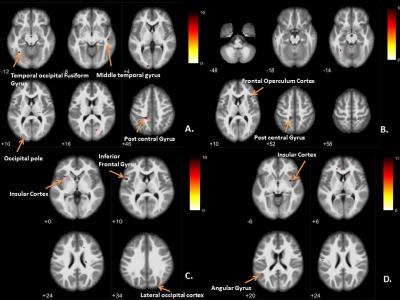4514
Assessment of neural correlates of cortical communication of Alpha/Gamma bands between frontal and parietal-occipital regions in Situational Awareness task as well as in resting-state: An EEG informed fMRI approach1Nuclear Magnetic Resonance Research Center, Institute of Nuclear Medicine & Allied Sciences,Defence Research and Development Organisation, Delhi, India, 2Applied Physics, Delhi Technological University, Delhi, India
Synopsis
Cross frequency coupling of Alpha/Gamma oscillations between frontal and parietal-occipital cortex coordinates neuronal communication at higher frequency which often correlates with higher-order cognitions. The dynamics of cross frequency coupling and neuronal communication is often modulated by higher-order cognition tasks while comparing resting-state. The neural correlates and modulation of these cortical communication caused by reciprocal relationship of alpha/gamma band between frontal and parietal-occipital regions are poorly understood. Hence in this study, cortical functional correlation of alpha/gamma oscillation between frontal and parietal-occipital region for higher-order cognitive task such as Situational Awareness is assessed and its modulation from resting-state has been explored.
Purpose
Assessment of neural correlates of cortical communication of Alpha/Gamma bands between frontal and parietal-occipital regions in Situational Awareness (SA) task as well as in resting-state through EEG informed fMRI approach.Method
Eighteen volunteers (mean age=24 years) participated in resting-state and SA task-fMRI study and their simultaneous EEG-fMRI data were acquired using 3T-MRI/MR compatible Brain-Amp EEG cap with 32 Ag/AgCl electrodes and then preprocessed. The SA task paradigm was designed to have three levels of SA such as perception, understanding and projection. Then, the frontal and parietal-occipital cortical region’s alpha, gamma EEG powers were computed independently for both resting-state and SA task studies. The neural correlates of cortical communication between frontal and parietal-occipital region were assessed by passing estimated band information as parametric modulator in canonical HRF based general linear model of the BOLD information separately for resting-state and SA task-fMRI studies. Subsequently, functional reciprocal cortical correlation of frontal alpha-frontal gamma, frontal alpha-parietal occipital gamma, parietal occipital alpha-parietal occipital gamma, parietal occipital alpha-frontal gamma were assessed at the first level processing and passed on to second level for group inferences through one way analysis of variance (ANOVA).Results
The neural correlates of reciprocal coupling between alpha/gamma bands for frontal and parietal-occipital regions for resting-state (Figure 1) and SA task-fMRI (Figure 2) is tabulated in Table 1. The results have been inferred using the F-contrast at an uncorrected p-value (p<0.001). The reciprocal coupling between frontal alpha and frontal gamma found significant correlation with precentral gyrus, lingual gyrus, super-marginal gyrus, superior parietal lobule and posterior cingulate gyrus for resting-state. In SA task, postcentral gyrus, occipital pole, temporal occipital fusiform gyrus, superior temporal gyrus and middle temporal gyrus correlated substantially with the BOLD. Desynchronization of frontal alpha and parietal-occipital gamma yields correlation with precentral gyrus, insular cortex and middle frontal gyrus in resting-state and postcentral gyrus and frontal operculum cortex in SA task. In case of Parietal-occipital alpha and posterior gamma, neural correlates were precentral gyrus, occipital fusiform gyrus and Frontal orbital cortex in resting-state. It is modulated to communication pathways through inferior frontal gyrus, lateral occipital cortex and insular cortex during SA task. Parietal-occipital alpha and frontal gamma combination correlates with insula in resting-state and with insula and angular gyrus in SA task.Discussion
In general, our result justifies the hypothesis that there exists reciprocal relationship of inhibition (alpha) and neuronal processing (gamma) results in cortical communication between the various brain regions. In addition, the task related modulation is observed in reciprocal relationship of inhibition and neuronal processing while comparing the resting-state.
1. Frontal alpha/frontal gamma coupling:
In resting-state, intra-frontal coupling of alpha/gamma band correlated primarily with posterior cortex corresponding to visual/sensory processing. These neural correlates are modulated (Table 1) to the regions generally known for higher order cognitive processing during SA task. This justifies the understanding that the involvement of higher order cognitive task brings the anti-correlated inhibition and neuronal processing at the frontal lobe1.
2. Frontal alpha/parietal-occipital gamma coupling:
During resting-state, interaction between frontal alpha and parietal-occipital gamma correlates with insular cortex and middle frontal gyrus. However, this interaction is modulated through frontal operculum cortex pathway during SA task. This supports the earlier findings2,3, that involvement of thalamic cortical circuits in coordinating the alpha/gamma oscillations between cortexes during higher cognitive tasks.
3. Parietal-occipital alpha/parietal-occipital gamma coupling:
Inferior frontal gyrus, lateral occipital cortex and insula as neural correlates of parietal-occipital alpha and gamma during task suggests role of attentional control and spatial perception4,5 in modulating inhibition/neuronal communication at the parietal-occipital cortex from fusiform gyrus to lateral occipital gyrus6.
4. Parietal-occipital alpha/frontal gamma coupling:
In this combination, the angular gyrus is recruited as additional neural correlates during SA task in addition to insula which was common in both resting and SA task7.
Conclusion
The neural correlates observed in SA task as well as resting-state justifies the hypothesis that the cortical communication between frontal and parietal-occipital cortex is coordinated by reciprocal correlation of alpha/gamma oscillations.Acknowledgements
No acknowledgement found.References
1. Bonnefond M, Jensen O. The role of gamma and alpha oscillations for blocking out distraction. Communicative & Integrative Biology. 2013;6(1):e22702.
2. Palva Satu. Multimodal Oscillation-based Connectivity Theory. Helsinki: Springer; 2016 p. 69-86.
3. Quax S1, Jensen O2, Tiesinga P1. Top-down control of cortical gamma-band communication via pulvinar induced phase shifts in the alpha rhythm. PLoS Comput Biol. 2017;13(5):e1005519.
4. Hampshire A, Chamberlain SR, Monti MM, Duncan J, Owen AM. The role of the right inferior frontal gyrus: inhibition and attentional control. Neuroimage. 2010;50(3):1313-9.
5. Andersen RA. Encoding of intention and spatial location in the posterior parietal cortex. Cereb Cortex. 1995;5(5):457-469.
6. Tallon-Baudry C, Bertrand O, Henaff MA, Isnard J, Fischer C. Attention modulates gamma-band oscillations differently in the human lateral occipital cortex and fusiform gyrus. Cereb Cortex. 2005;15(5):654-62.
7. Tu Y, Zhang Z, Tan A, Peng W, Hung YS, Moayedi M, Iannetti GD, Hu L. Alpha and gamma oscillation amplitudes synergistically predict the perception of forthcoming nociceptive stimuli. Hum Brain Mapp. 2016;37(2):501-14.
Figures

